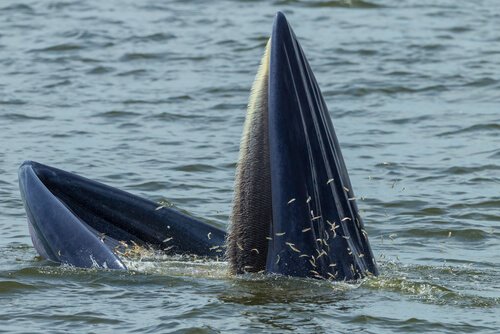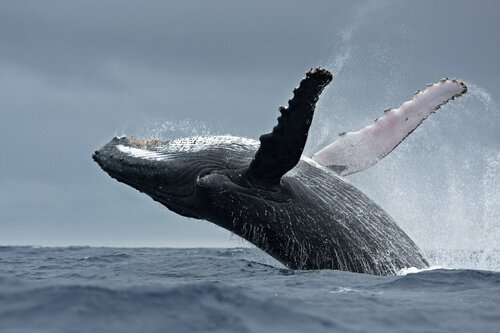The feeding of the whales
Whales are the giants of the oceans and, logically, they need to ingest a large amount of food to maintain a stable metabolism. The feeding of the whales usually varies according to their species, the availability of food in their habitat and the time of year.
Despite their rather calm and sociable temperament , whales are great predators. Their nutrition can include almost all types of vertebrates and invertebrates that share their environment, from fish to microscopic organisms.
Next, we will summarize the main aspects of the feeding of the whales; We will consider the most recognized species for this.
Types of whales in the oceans
Currently about 40 species of whales, whose nutrition is based mostly on the consumption of proteins of animal origin. These species are classified into two large groups:
- Mysticettes, whales with barbs or beards. These cetaceans have horny plates that act as a sort of filter and are popularly known as beards. The mysticeps or barbels are the main hunting tool of these species, among which we find the yubarta, the blue whale and the gray whale.
- Odontocetos, the whales with teeth. These species are smaller than the previous ones, and they can even be confused with dolphins. The teeth of these whales must all be of the same size and shape. In this classification are the right whales (glacial, austral, Pacific and Greenland).
Baleen whale feeding
Baleen whales are fed by a filtering system that is makes possible thanks to their beards. When they open their mouths, these cetaceans swallow as much water as possible, and then they push their tongue towards the beards.
With this movement, they are able to filter through the body. they expel water and retain their prey, which can be krill, plankton and small fish. Species that live close to the surface also take advantage of small mollusks, crustaceans and worms.
Feeding the whales with teeth (odontocetes)
The whales with teeth or odontocetos use their teeth to catch their prey and then swallow them completely. Despite their privileged dentition, they do not use their teeth to chew, but to catch fish, lobsters, squid, octopus and jellyfish, which are their 'favorite' foods.
These cetaceans are relentless hunters and can even catch sharks, sea lions and polar bears when there are fewer easy prey.
When capturing large animals, these whales are forced to chop their prey, to be able to swallow it little by little. Even in these cases, the chewing process is practically zero.
Feeding the calves
Feeding of newborn whales is limited to the consumption of milk produced by their progenitor. In general, females give birth to only one calf per calving, unless twins are born, which occurs with very little frequency in these cetaceans.
The period of lactation can extend up to one year , at the end of which the organism of the callenato already will be able to digest other types of foods.This is essential for the development of the calves.
How much does a whale eat per day?
The amount of food eaten by a whale will depend on its species and its own organism, as well as the type of food available in its habitat and the time of year. In general, an adult whale needs to eat daily the equivalent of 4% of its body weight.

During the summer, whales usually increase their food consumption , as they prepare for migratory trips and food shortages in winter.
Generally, these cetaceans do not usually eat during their migrations. Even if they have not managed to consume enough food in summer, they can take advantage of catching prey while on the move.
On their migratory journeys, whales spend a lot of energy and eat little, They lose a lot of fat. When they reach their destination, they need to increase their appetite again to regain strength and keep their metabolism stable.



